One of the gifts I received for my 60th birthday was a dedicated astronomy camera–the ZWO ASI533MC Pro. One of my first targets for this new camera was the Orion Nebula.
I was pretty pleased with the way this image turned out, although it required quite a bit of processing. Seeing conditions were not the greatest when the image was taken. This image is a composite of about 50 subexposures each at 15, 30, 60, and 180 seconds. The shorter subs were used to capture the detail in the brightest parts of the image, while the longer subs captured the fainter detail around the edges. I used Topaz Labs’ Sharpen AI software to sharpen the image a bit because of the poor seeing conditions when the image was captured.
The image was captured through my Sky-Watcher Esprit 100 apochromatic refractor telescope on an iOptron GEM45 mount. My image capture tool chain includes NINA for capturing the images (as well as autofocusing), PHD2 for guiding (I use a William Optics 50 mm UniGuide guide scope and a ZWO ASI290MM Mini guide camera), Stellarium for pointing the telescope and locating targets, and ASCOM drivers to interface to all the hardware.
When it comes time to process the image, I use Deep Sky Stacker to stack all the subexposures, and then Affinity Photo to process the stacked image. I frequently use the ProDigital AstroFlat Pro Photoshop plugin (Affinity Photo is compatible with at least most Photoshop plugins) as well as a couple tools from Topaz Labs–Sharpen AI and Denoise AI.
You can see all the astrophotos I’ve taken so far (at least the ones I’m willing to share) in my astrophotography gallery.

